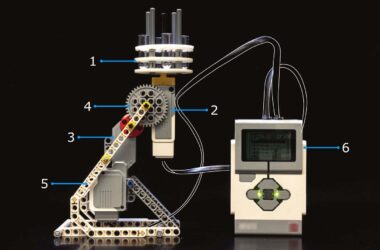A binocular imaginative and prescient system consisting of two synthetic compound eyes, every containing 37 gentle sensorsZhiyong Fan et al. (2024)
Cameras impressed by the compound eyes of bugs allow an especially large area of view with out costly lenses, probably providing low-cost, easy and light-weight visible sensors for navigation or monitoring in robots and driverless vehicles.
Bugs like dragonflies have eyes that, in pairs, present an virtually 360-degree visual field and assist them to deftly evade predators. Their eyes are composed of many ommatidia, that are primarily tubes with a easy lens at one finish and a primary photoreceptor on the different. Their imaginative and prescient is made up of pixel-like inputs from massive bundles of those ommatidia.
Creating cameras that may affordably obtain the identical factor, both by protecting a hemisphere with picture sensors or by creating a number of lenses to direct gentle onto a central sensor, has proved difficult. Now Zhiyong Fan and his colleagues on the Hong Kong College of Science and Expertise have replicated the structure of insect eyes utilizing nanowires made out of a crystal materials known as perovskite, with out the necessity for exactly manufactured lenses.
Their design consists of a 3D-printed hemisphere round 2 centimetres throughout with 121 openings, every 1 millimetre in diameter, that act like a easy pinhole digicam. In every gap, a perovskite nanowire directs gentle from a really slim area of view immediately onto a light-weight sensor, and electronics mix the outcomes right into a single body. The factitious eye can generate photographs with a area of view of 140 levels, and an overlapping pair can lengthen this to 220 levels.
Fan says that this might be an enormous increase in sure robotics functions, comparable to in a swarm of drones flying in shut formation. “They should preserve a distance, perhaps just a few metres away from one another, so they should know the exact location and the relative velocity they’re approaching one another and transferring away from one another,” he says. “So the compound eye is essential; it has the broader area of view and likewise sensitivity for movement.”
The researchers additionally constructed a pair of smaller synthetic compound eyes with 37 gentle sensors. They fitted a quadcopter drone with this method and have been in a position to make use of it to trace a robotic canine on the bottom.
Fan says the compound eye design additionally advantages from being easy, gentle and low-cost, but it surely gained’t absolutely change conventional cameras. As an alternative, he thinks the units will present supplemental information that’s helpful for robots and different machines, comparable to self-driving vehicles.
Subjects:












